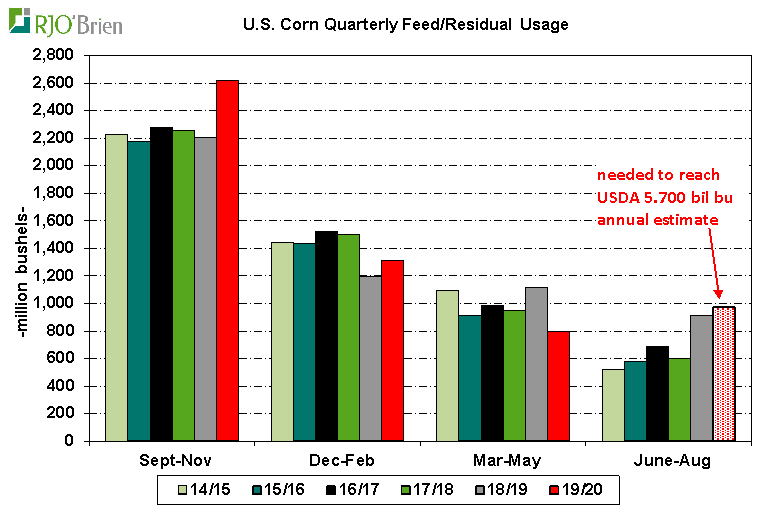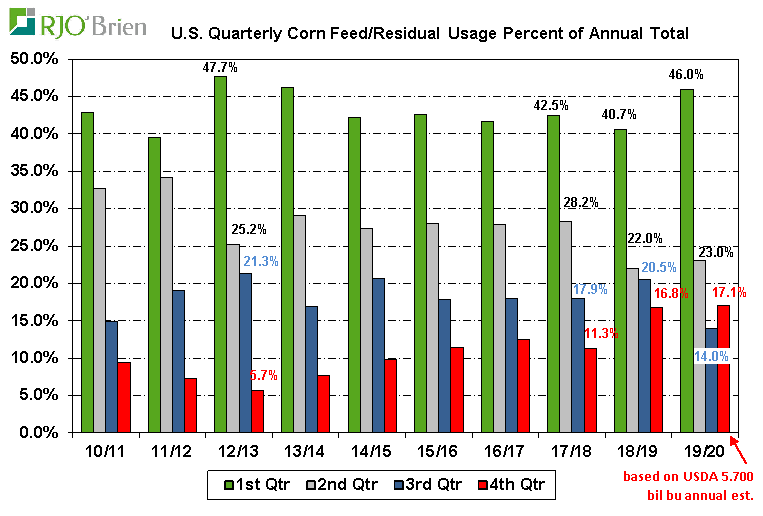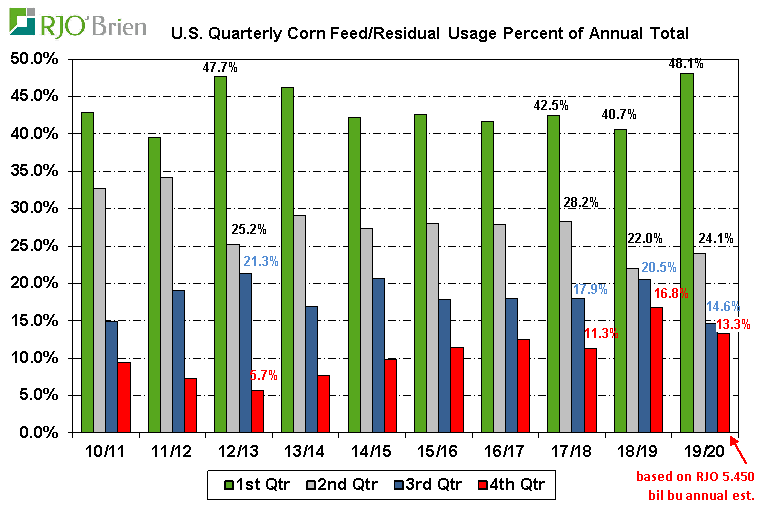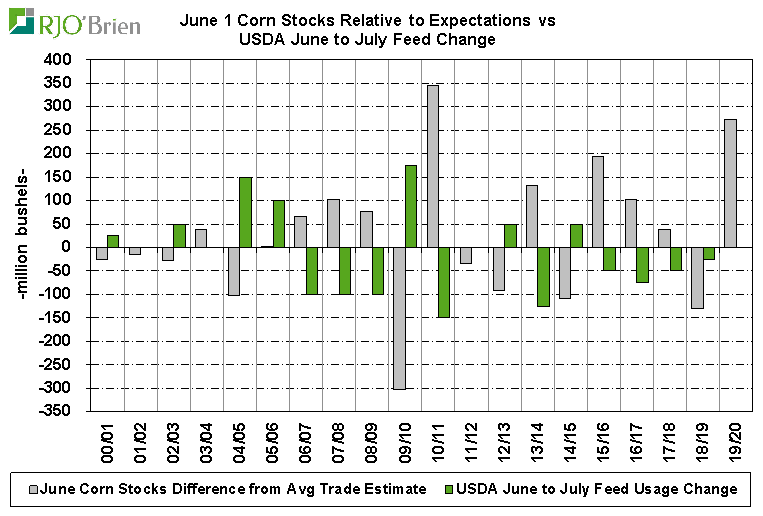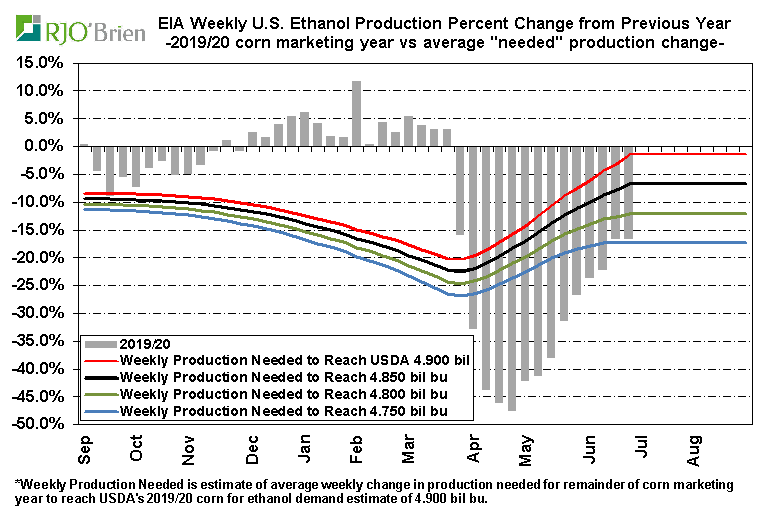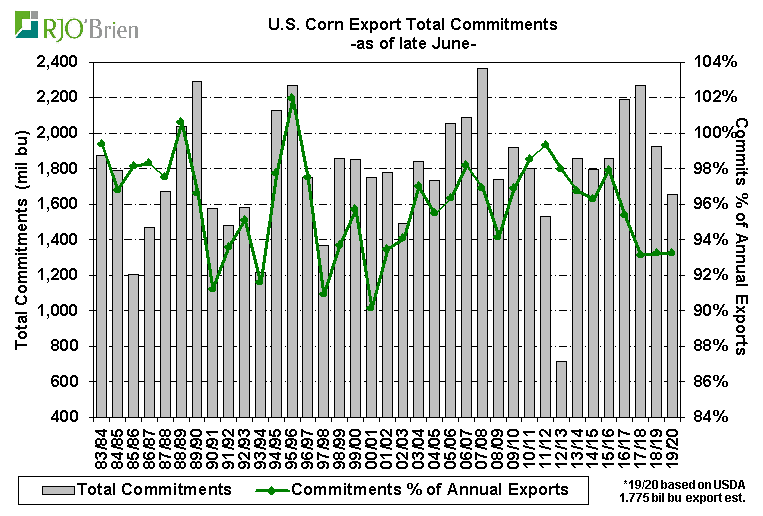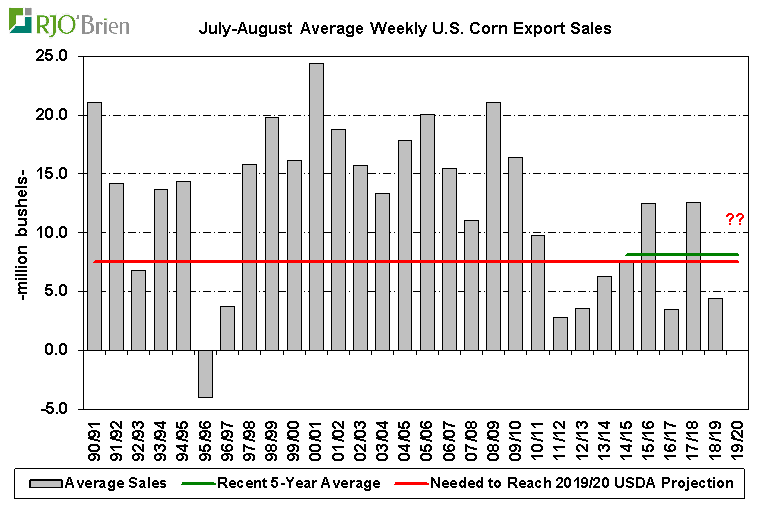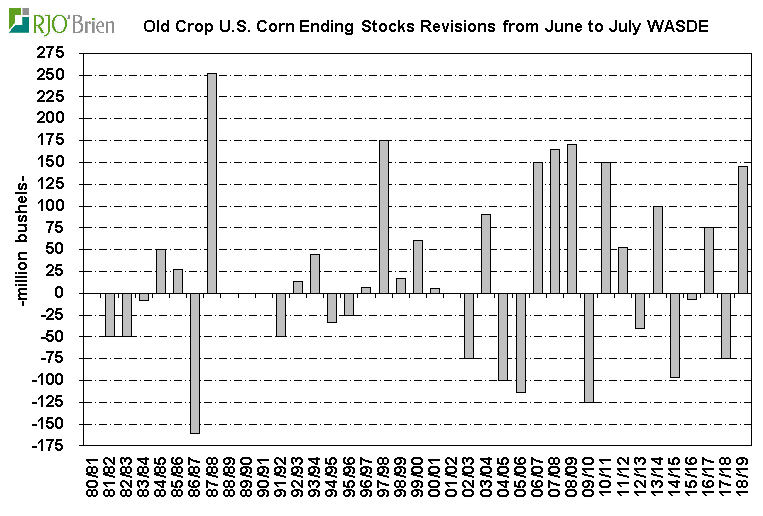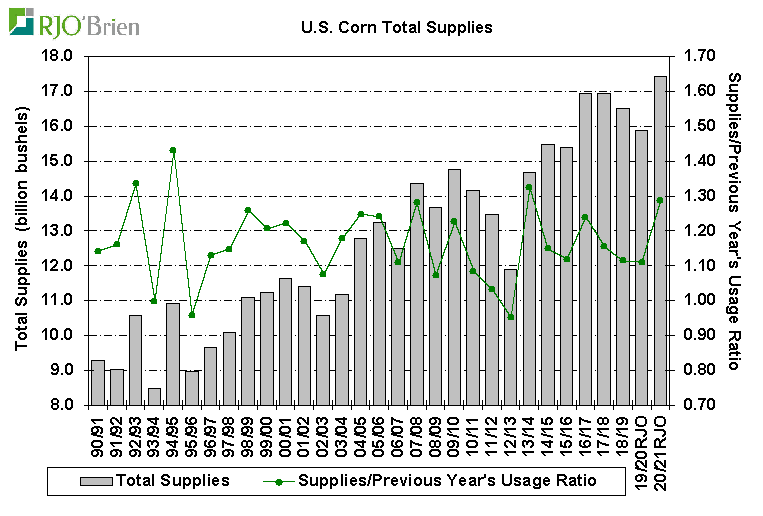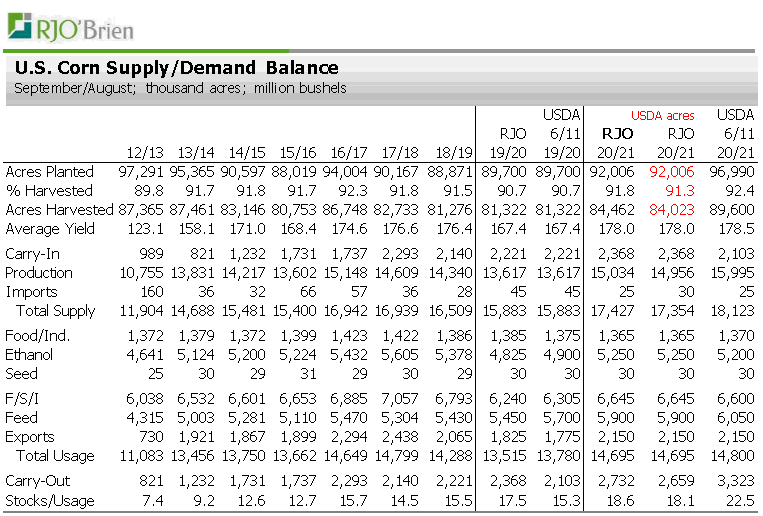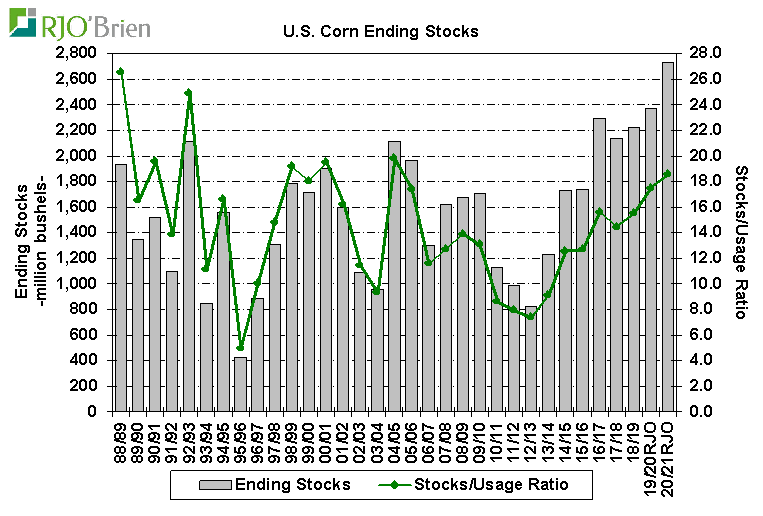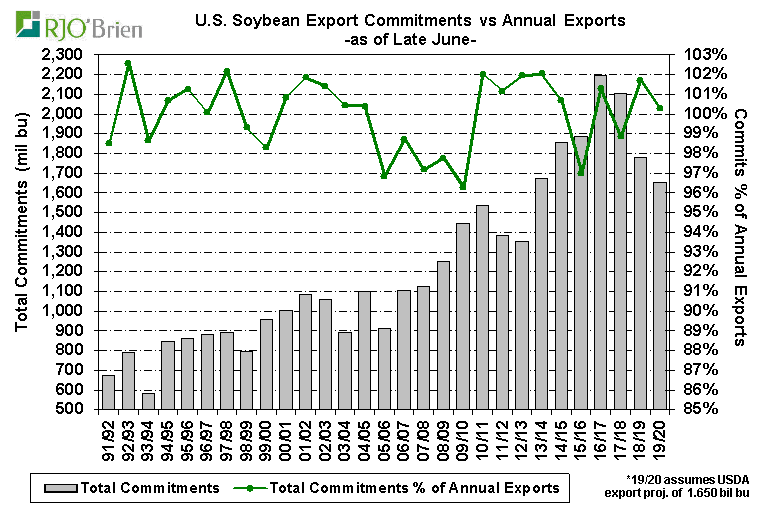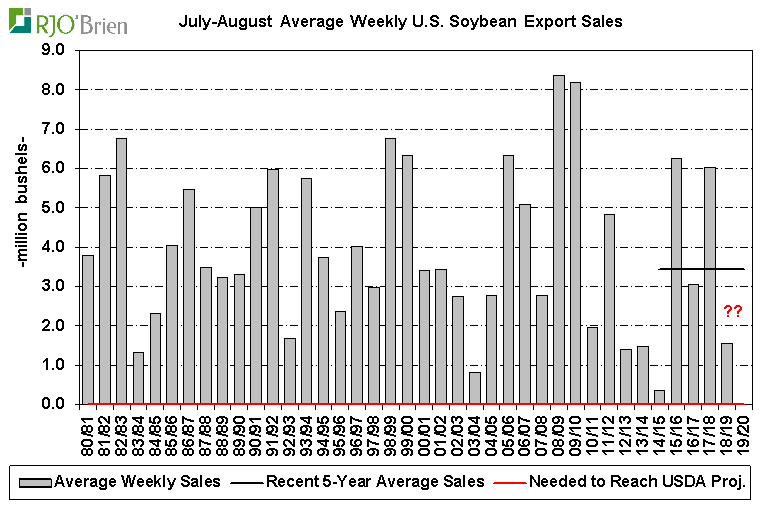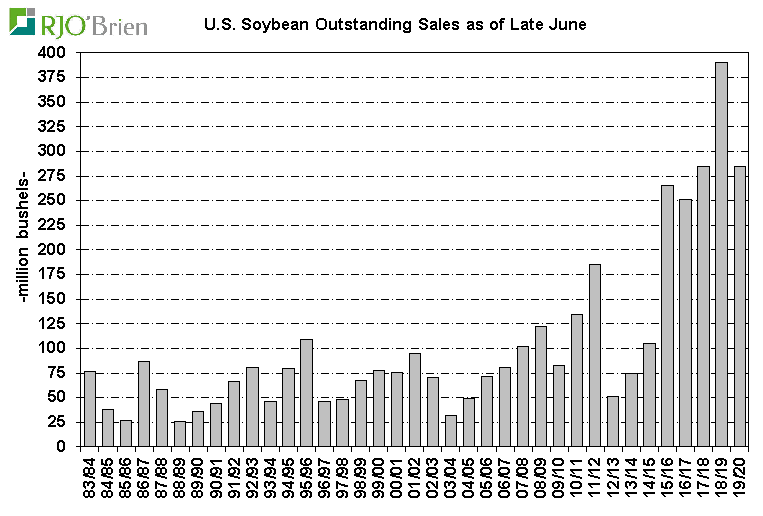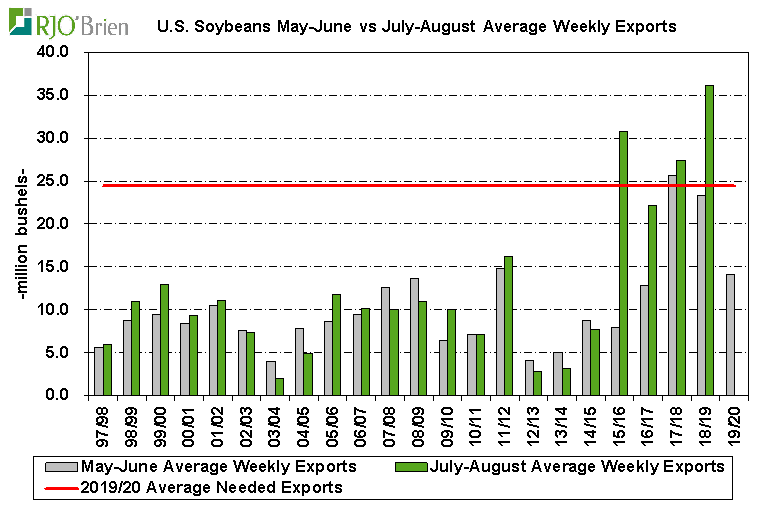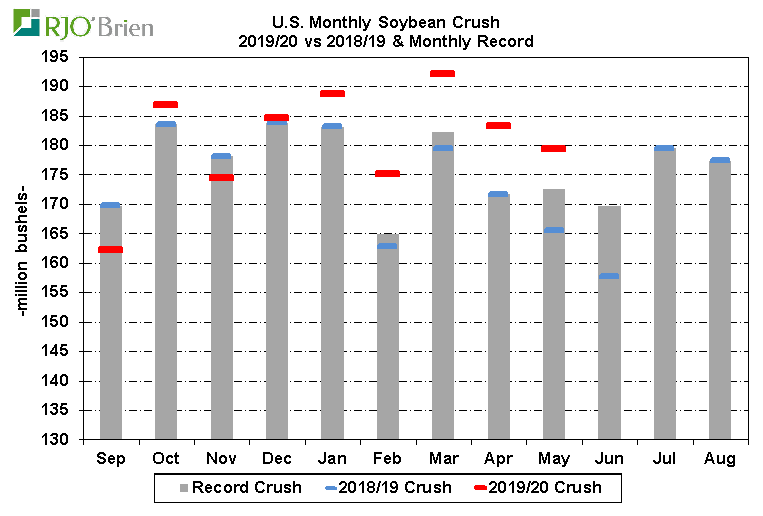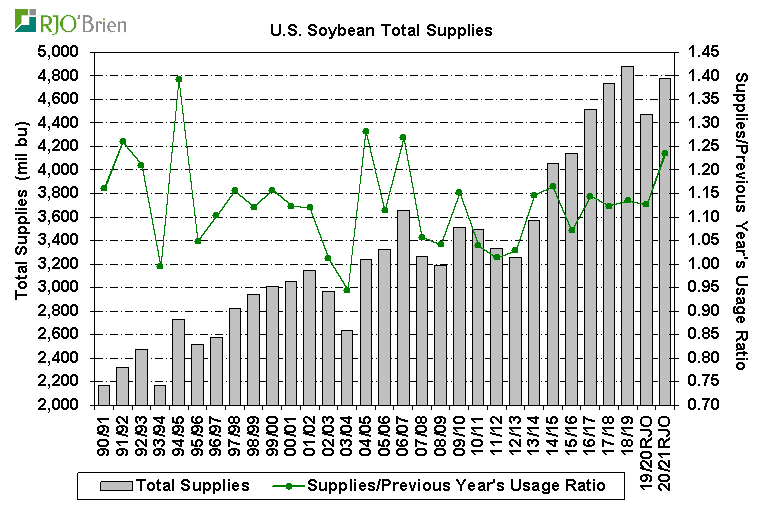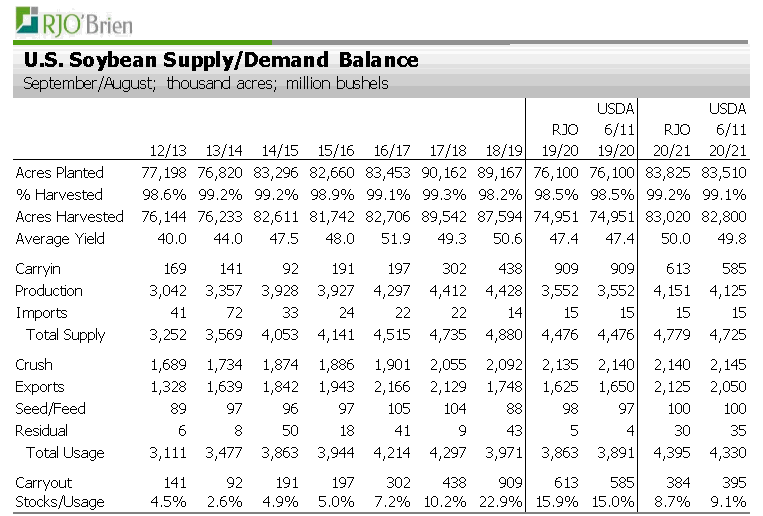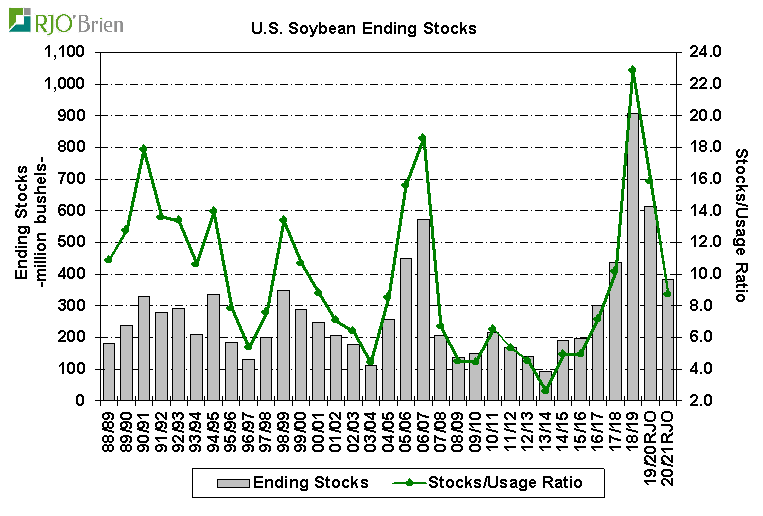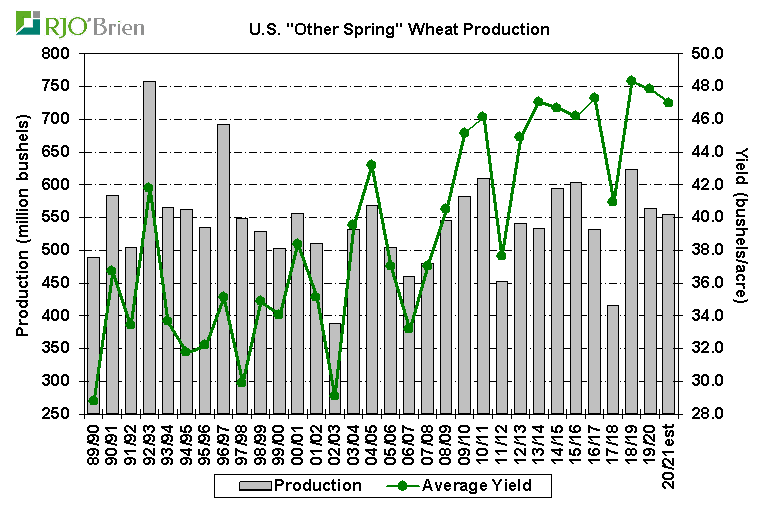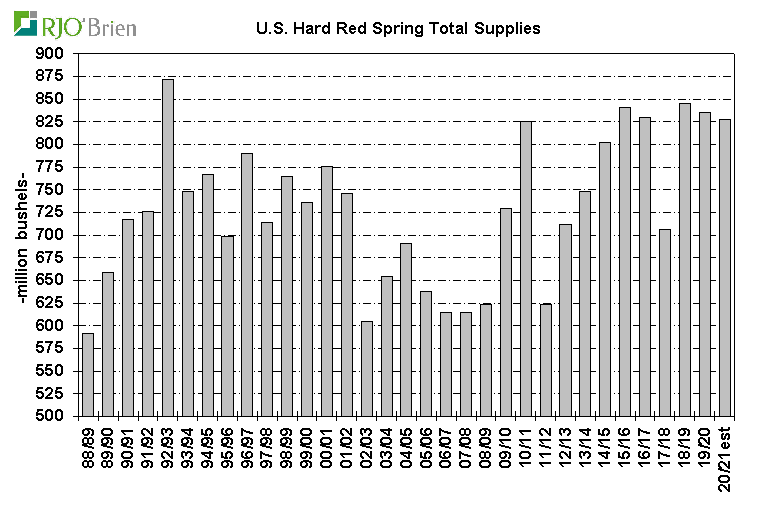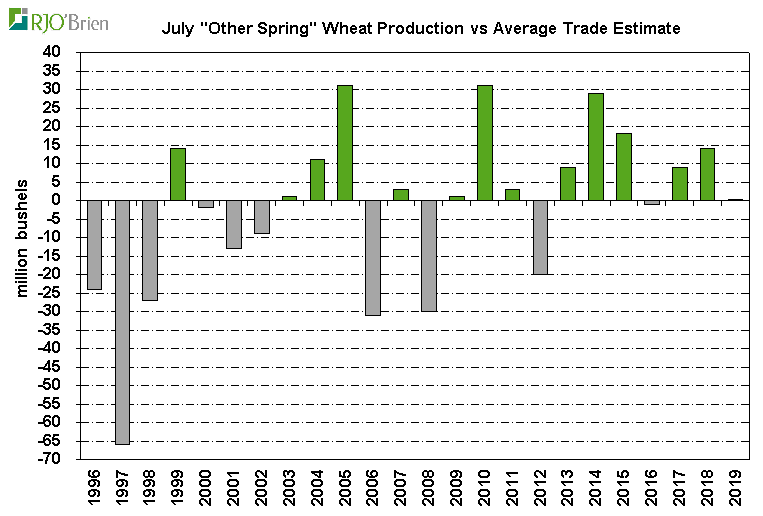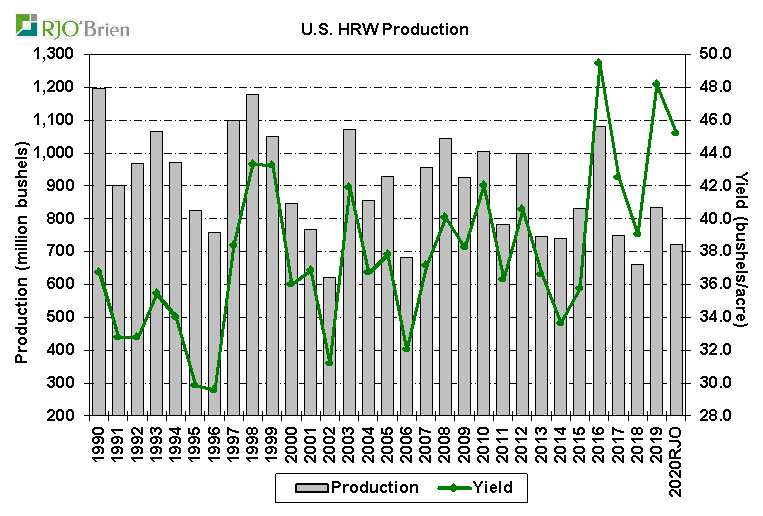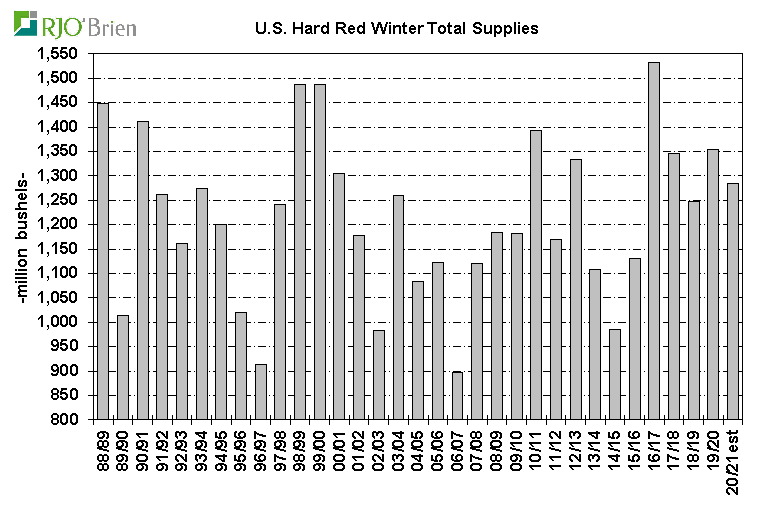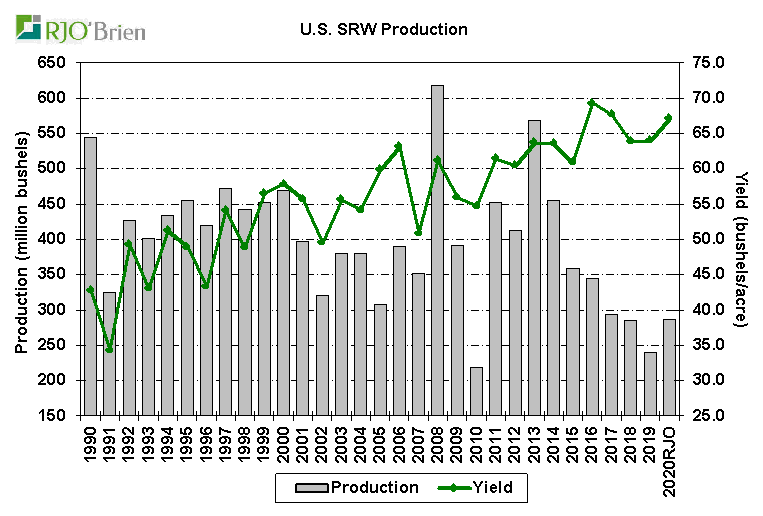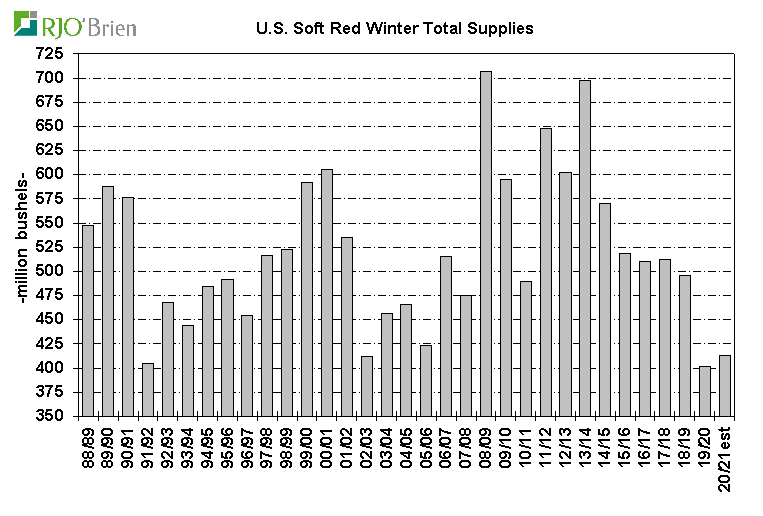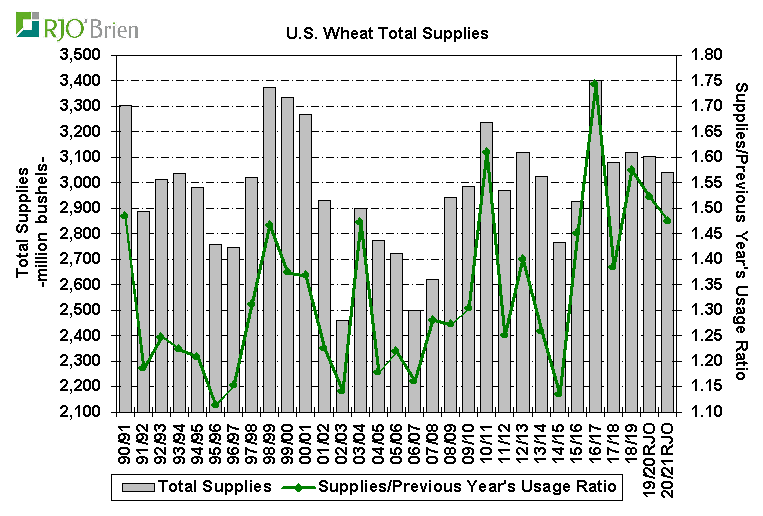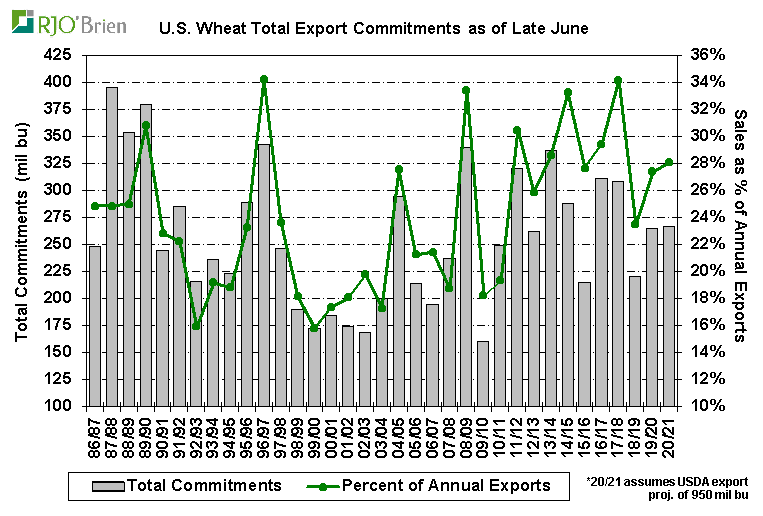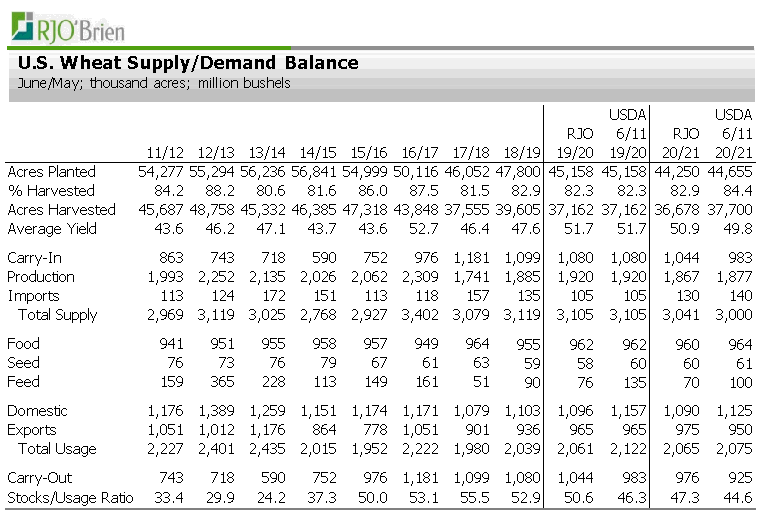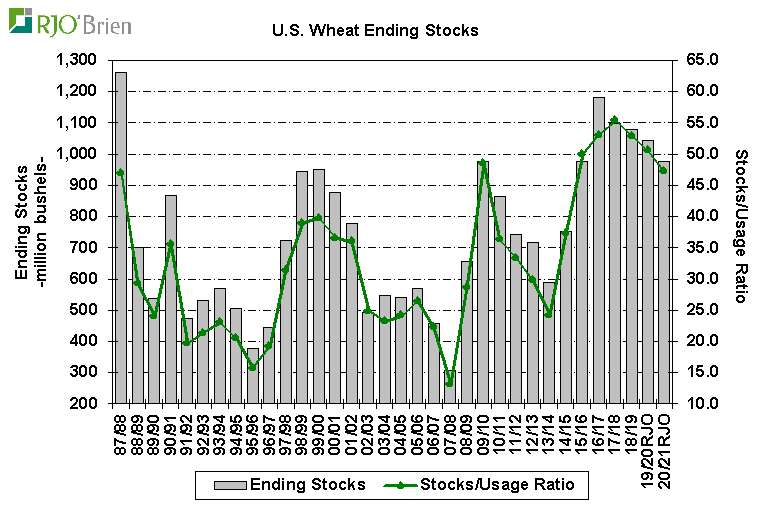Notable revisions are expected to the U.S. corn balance sheet this month as a result of the considerable surprises reflected in the USDA’s June 30 Grain Stocks report and Acreage report. The first objective estimate of this year’s spring wheat crop will also be released on Friday, and combined with the increase in old crop ending stocks revealed in the Grain Stocks report, higher U.S. wheat ending stocks are expected this month. Revisions to the U.S. soybean balance sheet could be limited this month. All eyes remain squarely on U.S. weather forecasts as the turn to hotter/drier conditions elevate yield concerns heading into the heart of the growing season.
Wire services had not yet posted average trade estimates for Friday’s reports as of this writing. Accordingly, we will provide a summary of them on Market Insights as soon as they become available.
Corn
The June 30 Grain Stocks and Acreage reports held considerable surprises for corn market. On one hand, the sharply higher-than-expected June 1 U.S. corn stocks estimate implied much weaker domestic demand of old crop corn than expected, while the much lower-than-expected estimate of 2020/21 U.S. corn acreage set the overall tone of the reports in getting the recent recovery underway. How USDA will likely handle the new crop acreage revision is fairly straight-forward. What isn’t, though, is how aggressive USDA may be on old crop demand as a result of the Grain Stocks report.
Without a doubt, USDA’s June 1 U.S. corn stocks estimate of 5.224 billion bushels, 273 million bushels above the average trade estimate, should prompt a solid reduction in their current 2019/20 U.S. corn feed/residual usage estimate of 5.700 billion bushels. Based on the June 1 stocks numbers, 3rd quarter (March-May) feed/residual usage was implied at roughly 795 million, 29% below last year’s likely statistical anomaly of 1.116 billion bushels (offset to the improbably low 2nd quarter usage), but also solidly below 3rd quarter feed usage in 2017/18 and 2016/17 of 951 million and 982 million bushels, respectively. Based on 1st-3rd quarter total feed/residual usage of 4.727 billion bushels, 4th quarter usage would need to be 974 million bushels, easily record high and even surpassing last year’s unrealistic reflecting of 4th quarter feed usage of 914 million bushels. Prior to last year’s apparent statistical anomaly, 4th quarter feed/residual usage had not been more than 700 million bushels in over 10 years.
Another way to look at this situation regarding the USDA’s current 5.700 billion bushel annual feed/residual usage estimate is by examining the percentage of feed usage accounted for each quarter of the marketing year. In recent years, the 4th quarter accounted for 10-12% of annual feed/residual usage, compared to 18-20% for the 3rd quarter, 27-28% for the 2nd quarter and 42-43% for the 1st quarter. Last year’s unusual situation of widely-varied implied quarterly feed/residuals resulted in 4th quarter usage reflecting nearly 17% of annual usage vs the 6-13% of the previous 10 years. Based on the USDA’s 5.700 billion bushel annual estimate, 4th quarter feed/residual usage would need to account for an even higher percentage of total usage this year at 17.1%, which would be the highest in 29 years. We simply do not see that being the case given the notable pullback in cattle on feed and broiler hatch during the quarter, even though hog numbers continued to post impressive gains for the quarter.
We do feel 3rd quarter implied feed/residual usage of 795 million bushels may be a bit low, possibly seeing a bit of a statistical offset in 4th quarter numbers. However, we still feel the USDA’s 5.700 billion bushel estimate is notably too high. We’re assuming 4th quarter feed/residual usage at 724 million bushels vs last year’s 914 million bushel (statistical anomaly), but would still be above 2017/18’s 600 million and 2016/17’s 687 million for the 2nd highest in 13 years. Even based on this historically strong 4th quarter usage, 2019/20 annual feed/residual usage would be only 5.450 billion bushels, 250 million below the USDA’s current estimate. Moreover, as seen in the 2nd chart below, our estimate would reflect 4th feed/residual usage accounting for 13% of annual usage, a bit more in line with recent years, but still a bit on the high side. We feel USDA is fully justified in lowering their 2019/20 annual feed/residual usage estimate by 150-200 million bushels based on the June 1 stocks figure and may wait until after the September Grain Stocks report before reflecting the likely full scope of the implications of the June stocks report.
The likelihood USDA does not fully reflect the higher than expected June 1 stocks figure in lower feed/residual usage is backed by the following look at past years’ June to July feed/residual usage revision relative to June 1 stocks vs the average trade estimate. USDA’s June to July feed/residual revision almost always goes in the “expected direction,†with higher than expected June 1 stocks prompting a decline in feed usage and vice versa. As seen, though, the degree of the feed usage revision, in most cases, does not match the degree of the deviation in June 1 stocks from expectations. The most “bearish surprise†on record for June 1 stocks of 346 million bushels in 2010/11 saw USDA lower feed/residual usage by 150 million bushels in July, while 2015/16’s 194 million bushels “bearish surprise†was followed by a mere 50 million bushel cut in feed usage in July.
While USDA may not fully account for the lower feed/residual usage potential in this month’s report, we do feel they must further lower their 4.900 billion bushel corn for ethanol usage estimate, as well. After April and May corn for ethanol usage was 44% lower and 35% lower than last year, respectively, a 355 million bushel year-over-year demand loss in the two months alone, a bit better of a recovery was seen in June with U.S. ethanol production down roughly 20% from last year. However, despite the recovery, we estimate 2019/20 marketing year-to-date corn for ethanol usage is down roughly 465 million bushels from last year, nearly accounting for the USDA’s currently-estimated annual decline of 478 million bushels with 9 weeks remaining in the year. Ethanol production would need to run nearly unchanged from last year during July and August to reach the USDA’s annual estimate, which obviously is not going to be the case with gasoline demand continuing to run well below year ago levels and COVID-19 cases spiking again in many states.
The following chart puts some perspective on potential additional corn for ethanol demand reductions based on various percentage declines in U.S. ethanol production through the end of August. If ethanol production runs roughly 7% below year ago levels, another 50 million bushel reduction in the USDA’s projection would be needed, while an average 12% decline would leave corn demand 100 million bushels lower and a 17% ethanol production decline 150 million bushels lower. Even this late in the marketing year, the additional demand reductions to the USDA’s balance sheet remain substantial. We’re estimating 2019/20 corn for ethanol usage at 4.825 billion bushels, 75 million below USDA and leaning lower.
The one modestly bright demand picture is exports. Over the last nine weeks, corn exports averaged 47 million bushels/week, 52% stronger than the same period last year. Additionally, old crop export sales ran nearly 86% stronger than last year during the same period. While 2019/20 total export commitments of 1.656 billion bushels are still down 14% from last year, they reflect 93% of the USDA’s annual export projection, right in line with the old crop sales pace relative to annual exports of the previous two years. Corn sales would only need to average roughly 7.5 million bushels/week through the end of August in order to reach the USDA’s projection. Given the solid pace of sales activity of late, we expect that to be modestly exceeded and look for 2019/20 exports 50 million above the USDA’s current estimate at 1.825 billion. While nice to see, the potential demand bump from exports pales in comparison to our estimated 325 million bushel demand loss from feed/residual usage and ethanol production combined.
We’re estimating 2019/20 U.S. corn ending stocks at 2.368 billion bushels vs USDA last at 2.103 billion. We do not anticipate USDA making a single-month 250-300 million bushel increase in the ending stocks estimate on Friday, but fully feel a 150+ million bushel increase could/should be made. It would be historic upward revision in old crop stocks for the July report, though, with the largest June to July stocks increase on record being 252 million bushels in 1987/88, but most other large-scale increases being limited to 150-175 million bushels.
For new crop, the expected revision to this year’s crop should be straight-forward as USDA directly applies the planted and harvested acreage figures from the June 30 Acreage report, while leaving their 178.5 bushel/acre yield assumption unchanged for the time being. In last week’s Acreage report, USDA put 2020/21 U.S. corn acreage at 92.006 million acres, nearly 5.0 million acres below March Prospective Plantings report estimate of 96.990 million, with harvested area estimated at 84.462 million acres, 5.1 million below their current balance sheet assumption of 89.6 million. Accordingly, their 2020/21 U.S. corn production assumption should decline to 15.076 billion bushels 15.995 billion currently. The 919 million bushel expected production cut will likely be at least moderately offset by higher old crop ending stocks, but a 700-800 million bushel reduction in total supplies from their 18.123 bushel estimate is likely.
There is no doubt last week’s Acreage report was a shock, coming in sharply below market expectations and putting a different perspective on the 2020/21 balance sheet than previous expected of an impending surge in ending stocks to well above 3.0 billion bushels. However, the situation still needs to be kept in perspective with total supplies still potentially record high as long as a notable crop problem is averted. The current hot/dry weather forecast obviously is raising eyebrows and adds another layer of risk to the new crop balance sheet. Despite the current forecast, we do not anticipate USDA revising their yield estimate this month as they have only made June to July yield changes a handful of times over the last 20 years, the last being a considerable 20 bu/acre cut in 2012/13, but only three other July yield revisions since 2000, a 0.5 bu/acre reduction in 2008, a 3.0 bu/acre reduction in 2005 and a 3.0 bu/acre increase in 2003. For now, though, a 178 bushel/acre yield would still leave 2020/21 total supplies above 17.4 billion bushels, up more than 1.5 billion bushels from last year’s 15.883 billion, even with the surprisingly low acreage estimate.
For new crop demand, we would expect USDA to lower 2020/21 feed/residual usage by some degree if a moderate downward revision is made to old crop demand as anticipated. On the other hand, we don’t see an immediate need to revise new crop corn for ethanol usage or export ideas relative to USDA’s current assumptions. A solid reduction in the USDA’s 3.323 billion bushel 2020/21 ending stocks should be forthcoming. We’re currently at 2.732 billion bushels, reflecting a much less fundamentally bearish situation than previously expected, but still burdensome by any definition. It will likely take a U.S. average yield of 170 bu/acre or lower to prompt a decline in new crop ending stocks below 2.0 billion bushels.
Soybeans
The USDA’s June 1 soybean stocks figure didn’t provide any surprises regarding the balance sheet so this month’s WASDE report should go along with typical analysis of the export and crush situations. Despite the 2019/20 export sales pace supporting the USDA’s 1.650 billion bushel export projection, the overall slow pace of actual shipments causes some concern final tallies may fall a bit short. Through late June, U.S. soybean export total commitments of 1.655 billion bushels were down 7% from last year’s 1.778 billion and were the lowest in seven years. However, given the low annual export expectations, sales on the books reflected 100.3% of the USDA’s export estimate, a common occurrence as seen in the following chart with late June sales typically above annual exports in most years since 2010/11. A certain amount of old crop sales always gets carried forward to the next marketing year, so as the year winds down, it is common for sales on the books to exceed eventual total exports.
Accordingly, with official Census Bureau export data through May revealing actual soybean exports 43 million bushels higher than those reported in Export Sales data, along with the level of sales already on the books, soybean export sales could essentially be zero through the end of the marketing year and still see 2019/20 exports reach the USDA’s 1.650 billion bushel export projection. Typically, July-August soybean sales average 1-5 million bushels/week and with China continuing to show up for at least modest old crop purchases, we do expect a modest amount of additional sales in the weeks ahead, which will continue to support ideas of achieving the USDA’s projection.
However, the actual pace of exports over the last several months is cause for concern for the likelihood of reaching the USDA’s export projection. Given the record Brazilian soybean exports in recent months, U.S. shipments have been quite limited. Accordingly, there are 280 million bushels in unshipped old crop U.S. soybean purchases on the books and, while it is below last year’s 390 million, as a result of China’s ban on U.S. supplies at the time, it is historically high. This increases the risk of a larger than usual amount of old crop sales being carried over to 2020/21. Of the 280 million bushels unshipped, only 115 million bushels are to China.
This concern is compounded by the slow pace of exports of late, even with such a large amount of unshipped sales already on the books. During May-June, U.S. soybean exports averaged only 14.1 million bushels/week vs last year’s 23.4 million/week and 2017/18’s 25.7 million. While each of the last two years also had historically large old crop unshipped sales on the books in early July, the shipment pace heading into the last two months of the year was substantially stronger than this year. Based on cumulative exports so far, we estimate soybean exports would need to average roughly 24.5 million bushels/week during July-August, 74% stronger than the pace over the last two months, in order to reach the USDA’s 1.650 billion bushel projection. It certainly is possible with the level of sales on the books, but a dramatic increase in loadings needs to start ASAP. We feel 2019/20 exports may fall a bit short of the USDA’s projection as we’re at 1.625 billion bushels.
We expect USDA to leave their 2.140 billion bushel 2019/20 crush estimate unchanged this month. Cumulative crush, through May, of 1.628 billion bushels is up 3.2% from last year’s 1.577 billion, leaving June-August crush needing to total 512 million bushels vs last year’s 515 million. Last year’s July-August crush was just below record levels and with current crush margins below each of the last six years in early July, there are concerns crush over the final two months of the year may not be able to maintain a record pace. For now, though, given the record crush in May of 179.6 million bushels, we expect USDA to hold the line for now.
The June 1 soybean stocks figure supported USDA’s current ideas of a historically low annual residual, currently estimated at 4 million bushels. With our slightly lower export estimate, we see 2019/20 U.S. soybean ending stocks at 613 million bushels vs USDA last at 585 million.
For new crop, the June 30 Acreage report, while also lower than expected for soybeans, did not result in needed considerable revisions from the USDA’s current 2020/21 balance sheet reflection. The 83.825 million acre planted area estimate and 83.020 million acre harvested area estimate were comparable to the USDA’s June WASDE assumptions of 83.510 million/82.8 million acres, respectively. We do not anticipate USDA revising their 49.8 bushel/acre yield assumption at this time as they have only made a change to the average yield in the July WASDE once over the last 24 years, a 3.4 bushel/acre reduction in 2012/13. Applying the June Acreage report figures to the current yield estimate would put the crop at 4.134 billion bushels, up a minor 9 million bushels from their current balance sheet reflection of 4.125 billion bushels. Accordingly, 2020/21 total supplies are expected to be around 4.750 billion bushels vs 4.476 billion last year thanks to the 7.7 million acre increase from 2019/20.
For new crop demand, USDA may not make too many changes this month. Export sales for 2020/21 are off to a respectable start. The market has been excited at times about new crop sales being reported to China, which is understandable given the contentious nature of trade between the U.S. and China in recent years, but perspective on the situation needs to be maintained. Through June 25, Export Sales data reflected total export commitments for the 2020/21 marketing year reached 255 million bushels, sharply above new crop sales at this time last year of only 91 million bushels, but fairly typical relative to the last five years and still significantly below early sales for 2012/13-2014/15. Current new crop sales on the books reflect 12% of the USDA’s 2020/21 export projection of 2.050 billion bushels, comparable to the average over the last five years of 10.4% of late June sales relative to eventual annual exports. As seen, though, during the 2011/12-2014/15 period, new crop sales at this time accounted for 21-38% of annual exports. Accordingly, while there is an abundance of optimism for a considerable increase in sales activity to China, which we do feel will be seen at some point, the pace of new crop sales so far justifies the USDA’s 2020/21 projection at this time. We are estimating next year’s exports above USDA, though, at 2.125 billion bushels.
We do not anticipate USDA making a noteworthy revision to their 2.145 billion bushel new crop crush estimate this month. With this in mind, the USDA’s 2020/21 U.S. soybean ending stocks estimate of 395 million bushels could tick a higher this month given the minor in the crop size, but we see any revision being largely fundamentally inconsequential. We’re currently estimating new crop ending stocks at 384 million bushels given our higher export ideas.
Wheat
The focus for wheat this month will likely be heavily on the USDA’s first objective estimate of the spring/durum wheat crops, along with the update of the winter wheat crop taking into account the acreage revisions from the June 30 report. Spring wheat crop conditions were under considerable pressure throughout June, declining from 82% good/excellent at the start of the month to 69% g/e by the end. This week’s conditions reflected a minor improvement to 70% g/e, but spring wheat conditions are below the last two years heading into the first crop estimate of the year. Overall, though, conditions are right in line with the average over the last 10 years for early July. As long as conditions stabilize, we’re expecting “other spring†wheat yields to slip from those of the last couple years, but still perform solidly. Our estimate of the “other spring†wheat crop is 554 million bushels vs last year’s 564 million, with the average yield at 47.0 bushels/acre vs 47.9 and 48.3 the last two years, respectively.
Specifically for hard red spring wheat, we estimate the crop at 515 million bushels vs 522 million last year, putting 2020/21 total supplies at an estimated 827 million bushels, little-changed from last year’s 835 million and the most-recent 5-year average of 812 million bushels.
The USDA’s July estimate of the spring wheat crop has not held many surprises in recent years, with last year’s report coming in dead on with the average trade estimate and the previous four years’ July estimates being within 18 million bushels of the average estimate.
The June 30 Acreage report reflected total winter wheat planted area down 225k acres from previous estimates, but more importantly, harvested area was revised to 23.439 million acres, 836k acres below the estimate used for the June Crop Production report of 24.275 million acres. While yield reports have been coming in as “better than expected,†the 800k+ acre decline in harvested area is expected to push the winter wheat crop lower this month. We see the all winter wheat crop at 1.238 billion bushels vs USDA last month at 1.266 billion. On a by-class basis, we estimate the hard red winter wheat crop at 721 million bushels vs USDA last at 743 million, soft red winter at 287 million vs 297 million last month and white at 230 million vs 225 million last month. Of the 836k acre decline in harvested area, the three major HRW states of KS, TX and CO accounted for 500k acres combined.
Based on our by-class production estimates, we see 2020/21 HRW total supplies at 1.285 billion bushels vs 1.354 billion last year and SRW total supplies at 413 million bushels vs 402 million last year. We estimate the total white wheat crop at 279 million bushels vs 272 million last year and the durum wheat crop at 65 million bushels vs 54 million last year. All together, we see the 2020/21 U.S. all wheat crop at 1.867 billion bushels vs USDA’s “working estimate†of 1.877 billion bushels last month (objective winter wheat estimate of 1.266 billion/total spring wheat assumption of 611 million bushels) and 1.920 billion bushels last year, for total supplies of 3.041 billion bushels vs 3.105 billion last year.
For the balance sheets, USDA has some clean-up to do on the 2019/20 situation following the much higher-than-expected June 1 stocks estimate of 1.044 billion bushels vs their current old crop ending stocks estimate of 983 million bushels. Based on official May trade data, 2019/20 exports ended up right in line with USDA’s 965 million bushel estimate. The 4th quarter (March-May) feed/residual was implied at a record low -99 million bushels, putting the 2019/20 annual feed/residual at 76 million bushels vs the USDA’s estimate in last month’s WASDE report of 135 million bushels.
For new crop, the 61 million bushel increase in carry-in stocks more than offsets our estimated 10 million bushel lower all wheat crop estimate than USDA assumed last month of 1.877 billion bushels. We feel USDA should lower their 2020/21 feed/residual usage estimate of 100 million bushels following the much lower-than-expected final 2019/20 usage, with each of the last three years’ feed/residuals being 90 million bushels or lower. Prospects for a considerable increase in U.S. corn supplies this year should also influence a downward revision, as well.
For exports, the 2020/21 U.S. wheat export program is off to an uneventful start with total commitments through the first month of the marketing year at 267 million bushels, essentially unchanged from last year’s 265 million and in line with average sales at this point over the last five years of 264 million bushels. Moreover, total commitments currently represent 28% of the USDA’s 950 million bushel export projection, in line with last year’s late June sales accounting for 27% of annual exports, indicating there is no need for a revision to the USDA’s estimate at this time. We’re slightly more optimistic on exports this year at 975 million bushels.
We’re currently estimating 2020/21 U.S. wheat ending stocks at 976 million bushels vs USDA’s 925 million bushel estimate last month and 1.044 billion in 2019/20. Wheat stocks have been slowly coming down in recent years, but still remain more than ample in historical terms. Our current 47.3% stocks/usage ratio estimate is below each of the last five years, which ranged from 50.0-55.5%, but prior to this period, our current estimate would have still been the 2nd highest of the previous 28-year period.

